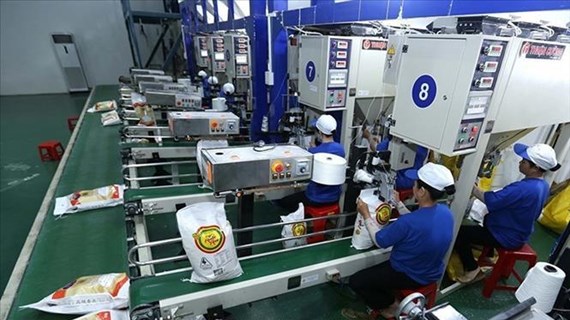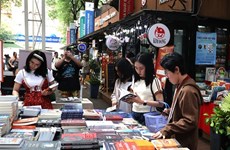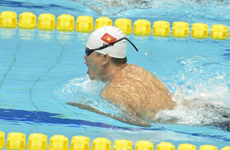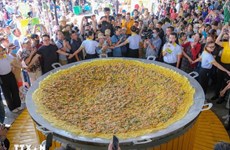Conservationists discuss Hue carvings
Leading conservationists nationwide have recently gathered in central
Hue city to discuss the poetry that is carved on wooden and concrete
heritage buildings in the former royal capital city.
Leading conservationists nationwide have recently gathered in central
Hue city to discuss the poetry that is carved on wooden and concrete
heritage buildings in the former royal capital city.
The conservationists also will seek ways to protect this poetry.
Despite Han Chinese characters being used for transcription of the poems, they are still different from carved calligraphy found on ancient buildings in China, the conservationists agreed.
According to Vu Thi Minh Huong, Chairwoman of the National Committee for Memory of the World Programmes, poetry carved on imperial buildings in Hue and the Nguyen dynasty (1802-1945) woodprints included poems for the general public.
"This gives a unique feature to those transcriptions, as they were not only for the rulers. They reflected the literature under the Nguyen dynasty," she said.
The conservationists showed their admiration for the large number of poems, as well as the diversity of poems found on the buildings. Carved poems can be seen at Thai Hoa Palace, The To Temple, Hung To Temple inside the former imperial palace, as well as in mausoleums of Kings Minh Mang, Thieu Tri, Dong Khanh, and Duc Duc, and in pagodas and the residences of royal families and mandarins.
Member of UNESCO Vietnam, Dang Van Bai, noted that Hue, or its heritage buildings, are a museum of the country's ancient poetry.
The uniqueness of the poetry comes from its content, the special carving techniques, and the transcription style. A poem by King Thieu Tri, for instance, was transcribed in the shape of a ship's rudder, with words carved in a circle and lines of words travelling outwards from the centre of the circle.
While the poem has 56 words, the rudder transcription generates 128 ways of reading and all present a complete and meaningful poem.
The conservationists agreed that conservation of the buildings is the prerequisite for the preservation of the poetry system.
They also offered their strong consensus that more study and documentation of the poetry is necessary for profiling and presenting them prior to consideration of recognition by UNESCO.-VNA
The conservationists also will seek ways to protect this poetry.
Despite Han Chinese characters being used for transcription of the poems, they are still different from carved calligraphy found on ancient buildings in China, the conservationists agreed.
According to Vu Thi Minh Huong, Chairwoman of the National Committee for Memory of the World Programmes, poetry carved on imperial buildings in Hue and the Nguyen dynasty (1802-1945) woodprints included poems for the general public.
"This gives a unique feature to those transcriptions, as they were not only for the rulers. They reflected the literature under the Nguyen dynasty," she said.
The conservationists showed their admiration for the large number of poems, as well as the diversity of poems found on the buildings. Carved poems can be seen at Thai Hoa Palace, The To Temple, Hung To Temple inside the former imperial palace, as well as in mausoleums of Kings Minh Mang, Thieu Tri, Dong Khanh, and Duc Duc, and in pagodas and the residences of royal families and mandarins.
Member of UNESCO Vietnam, Dang Van Bai, noted that Hue, or its heritage buildings, are a museum of the country's ancient poetry.
The uniqueness of the poetry comes from its content, the special carving techniques, and the transcription style. A poem by King Thieu Tri, for instance, was transcribed in the shape of a ship's rudder, with words carved in a circle and lines of words travelling outwards from the centre of the circle.
While the poem has 56 words, the rudder transcription generates 128 ways of reading and all present a complete and meaningful poem.
The conservationists agreed that conservation of the buildings is the prerequisite for the preservation of the poetry system.
They also offered their strong consensus that more study and documentation of the poetry is necessary for profiling and presenting them prior to consideration of recognition by UNESCO.-VNA












